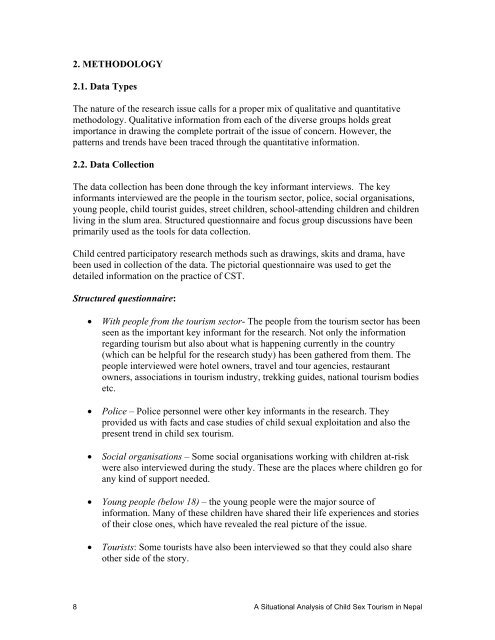A Situational Analysis of Child Sex Tourism in Nepal (Kathmandu ...
A Situational Analysis of Child Sex Tourism in Nepal (Kathmandu ...
A Situational Analysis of Child Sex Tourism in Nepal (Kathmandu ...
You also want an ePaper? Increase the reach of your titles
YUMPU automatically turns print PDFs into web optimized ePapers that Google loves.
2. METHODOLOGY<br />
2.1. Data Types<br />
The nature <strong>of</strong> the research issue calls for a proper mix <strong>of</strong> qualitative and quantitative<br />
methodology. Qualitative <strong>in</strong>formation from each <strong>of</strong> the diverse groups holds great<br />
importance <strong>in</strong> draw<strong>in</strong>g the complete portrait <strong>of</strong> the issue <strong>of</strong> concern. However, the<br />
patterns and trends have been traced through the quantitative <strong>in</strong>formation.<br />
2.2. Data Collection<br />
The data collection has been done through the key <strong>in</strong>formant <strong>in</strong>terviews. The key<br />
<strong>in</strong>formants <strong>in</strong>terviewed are the people <strong>in</strong> the tourism sector, police, social organisations,<br />
young people, child tourist guides, street children, school-attend<strong>in</strong>g children and children<br />
liv<strong>in</strong>g <strong>in</strong> the slum area. Structured questionnaire and focus group discussions have been<br />
primarily used as the tools for data collection.<br />
<strong>Child</strong> centred participatory research methods such as draw<strong>in</strong>gs, skits and drama, have<br />
been used <strong>in</strong> collection <strong>of</strong> the data. The pictorial questionnaire was used to get the<br />
detailed <strong>in</strong>formation on the practice <strong>of</strong> CST.<br />
Structured questionnaire:<br />
• With people from the tourism sector- The people from the tourism sector has been<br />
seen as the important key <strong>in</strong>formant for the research. Not only the <strong>in</strong>formation<br />
regard<strong>in</strong>g tourism but also about what is happen<strong>in</strong>g currently <strong>in</strong> the country<br />
(which can be helpful for the research study) has been gathered from them. The<br />
people <strong>in</strong>terviewed were hotel owners, travel and tour agencies, restaurant<br />
owners, associations <strong>in</strong> tourism <strong>in</strong>dustry, trekk<strong>in</strong>g guides, national tourism bodies<br />
etc.<br />
• Police – Police personnel were other key <strong>in</strong>formants <strong>in</strong> the research. They<br />
provided us with facts and case studies <strong>of</strong> child sexual exploitation and also the<br />
present trend <strong>in</strong> child sex tourism.<br />
• Social organisations – Some social organisations work<strong>in</strong>g with children at-risk<br />
were also <strong>in</strong>terviewed dur<strong>in</strong>g the study. These are the places where children go for<br />
any k<strong>in</strong>d <strong>of</strong> support needed.<br />
• Young people (below 18) – the young people were the major source <strong>of</strong><br />
<strong>in</strong>formation. Many <strong>of</strong> these children have shared their life experiences and stories<br />
<strong>of</strong> their close ones, which have revealed the real picture <strong>of</strong> the issue.<br />
• Tourists: Some tourists have also been <strong>in</strong>terviewed so that they could also share<br />
other side <strong>of</strong> the story.<br />
8 A <strong>Situational</strong> <strong>Analysis</strong> <strong>of</strong> <strong>Child</strong> <strong>Sex</strong> <strong>Tourism</strong> <strong>in</strong> <strong>Nepal</strong>
















